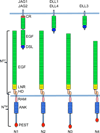The double-edged sword of Notch signaling in cancer
- PMID: 22309843
- PMCID: PMC3360804
- DOI: 10.1016/j.semcdb.2012.01.017
The double-edged sword of Notch signaling in cancer
Abstract
Recent deep sequencing of cancer genomes has produced an explosion of new data implicating Notch signaling in several human cancers. Unlike most other pathways, these data indicate that Notch signaling can be either oncogenic or tumor suppressive, depending on the cellular context. In some instances, these relationships were predicted from mouse models or presaged by developmental roles for Notch, but in other cases were unanticipated. This review discusses the pathogenic and translational significance of these new findings.
Copyright © 2012 Elsevier Ltd. All rights reserved.
Figures



References
-
- Radtke F, Fasnacht N, Macdonald HR. Notch signaling in the immune system. Immunity. 2010 Jan 29;32(1):14–27. - PubMed
-
- Pui JC, Allman D, Xu L, DeRocco S, Karnell FG, Bakkour S, et al. Notch1 expression in early lymphopoiesis influences B versus T lineage determination. Immunity. 1999 Sep;11(3):299–308. - PubMed
Publication types
MeSH terms
Substances
Grants and funding
LinkOut - more resources
Full Text Sources
Other Literature Sources

